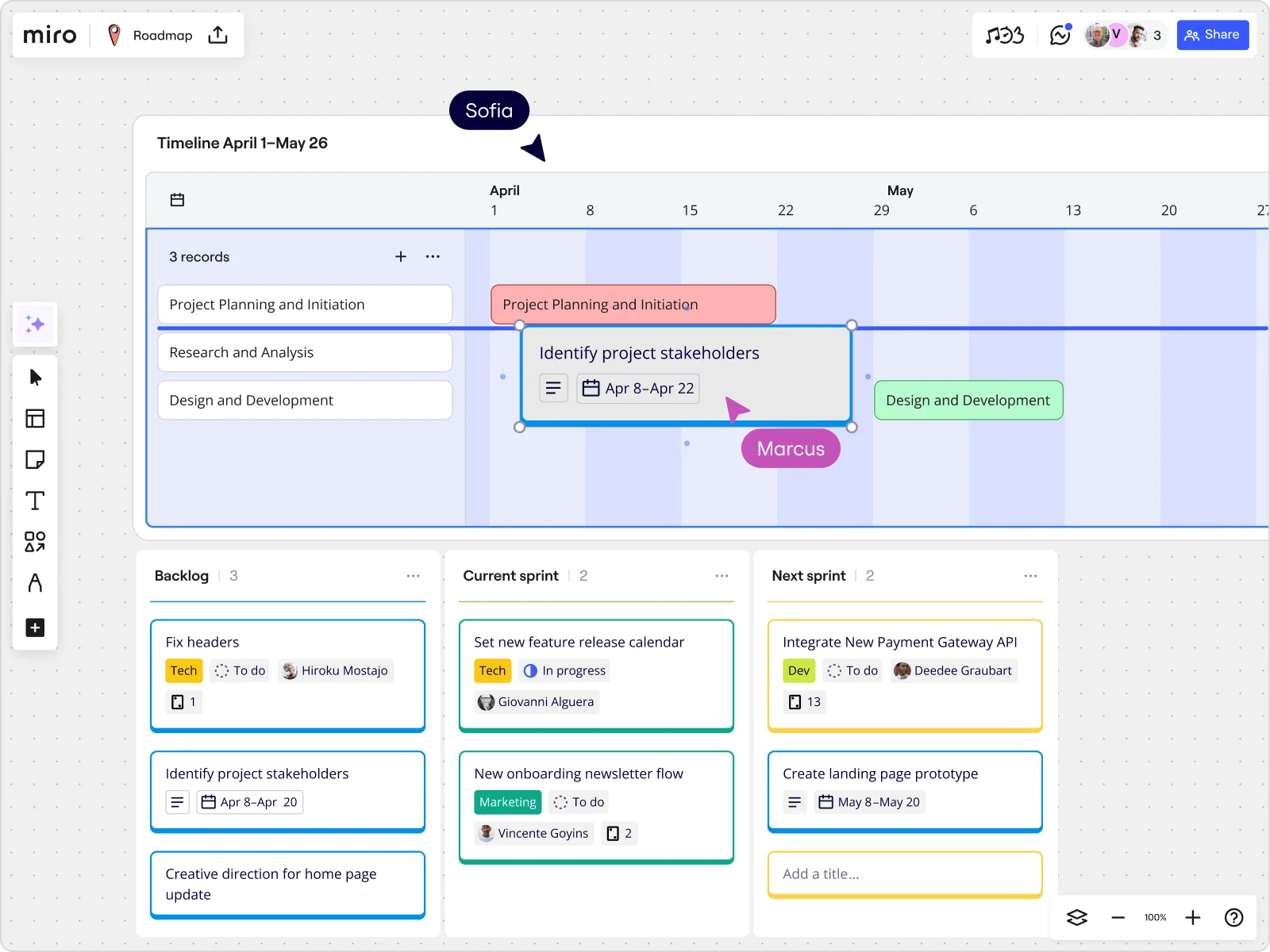
Product owner vs. product manager — everything you need to know

Summary
In this guide, you will learn:
- Distinct roles of product manager and product owner.
- Product manager: long-term strategy; product owner: short-term execution.
- How product managers and owners collaborate.
- Differences in decision-making and stakeholder engagement.
- When roles may overlap or combine.
- Agile's influence on role division.
Try Miro now
Join thousands of teams using Miro to do their best work yet.
Product Owner vs Product Manager (PO vs PM) are two roles often confused, but each plays a distinct part in the product lifecycle. Whether you’re working in Agile or another methodology, understanding the difference between product owner and product manager is critical to building successful products.
In this guide, we’ll break down the responsibilities of each role, explore their relationship, and answer common questions like whether one person can serve as both PO and PM.
What is a product manager?
A product manager (PM) is responsible for overseeing a product's entire lifecycle, from ideation to launch and beyond. PMs focus on strategy, market research, and aligning the product vision with business goals.
Product managers take on a variety of responsibilities to ensure the product meets both customer needs and business objectives. These include:
- Defining the product roadmap to align with organizational objectives.
- Conducting user research and gathering feedback to shape product features.
- Collaborating with stakeholders, including marketing, engineering, and sales teams.
- Prioritizing features based on market needs, feasibility, and impact.
PMs are the strategic drivers of the product, ensuring it remains competitive in the market.
What is a product owner?
A product owner (PO) works within an Agile framework, focusing on the execution of the product vision. They represent the customer in the product development process and ensure the team delivers value in each sprint.
Product owners handle key responsibilities that bridge the gap between stakeholders and development teams. These include:
- Managing the product backlog by creating, prioritizing, and refining user stories.
- Collaborating with the development team to clarify requirements and remove blockers.
- Ensuring each sprint delivers value aligned with the product vision.
- Acting as the main point of contact between stakeholders and the development team.
The PO role is tactical, focusing on delivering features efficiently and iteratively.
Key differences between PO and PM
Understanding the difference between product owner and product manager lies in their focus areas and responsibilities.
Strategy vs. execution
The product manager focuses on long-term strategy and the overall product lifecycle, while the product owner works on executing that vision in short-term development cycles.
Market vs. team
PMs work closely with external stakeholders, customers, and market data. POs, on the other hand, primarily interact with the development team and internal stakeholders.
Decision-making scope
PMs make high-level decisions about the product’s direction, whereas POs prioritize and refine tasks within the development team.
These differences highlight how the roles complement each other, ensuring that both strategic goals and day-to-day tasks are aligned.

How product managers and product owners collaborate
PMs and POs must collaborate closely to ensure product success. Their roles are interconnected but distinct, requiring clear communication and mutual understanding.
Product owner vs. product manager vs. epic owner
An epic owner oversees large-scale initiatives that span multiple teams or projects. While PMs and POs focus on specific products, an epic owner ensures that broader organizational goals are met. This role often interacts with both POs and PMs to align efforts across the company.
Can a product owner also be a product manager?
In some cases, one person can take on both the PO and PM roles, especially in smaller organizations. However, this dual responsibility can create challenges:
- Competing priorities: Balancing strategic and tactical work may lead to inefficiencies.
- Role clarity: Confusion about responsibilities can affect team alignment.
While combining the roles may be feasible in certain contexts, separating them often ensures better focus and effectiveness.
AI product management
AI product management is a rapidly growing field that combines traditional product management principles with advanced AI technology. As industries embrace AI, the role of the product manager has evolved to meet new demands.
AI product managers oversee a range of critical tasks to guide the development of AI products and align them with customer and market needs. These include:
- Understanding AI capabilities and aligning them with customer needs.
- Navigating ethical considerations in AI, such as bias and transparency.
- Shaping strategies to leverage AI in solving real-world problems.
With the rise of AI products, product managers specializing in this field play a critical role in driving innovation and staying competitive.

Simplify product development with Miro
Collaborating Agile Product Owner vs Product Manager roles can be challenging, but the right tools make it easier.
Miro’s innovation workspace provides an AI-powered visual canvas that helps teams align on product vision, create user stories, and manage roadmaps—all in one place.
Sign up for Miro to get started.
Author: Miro Team
Last update: October 14, 2025